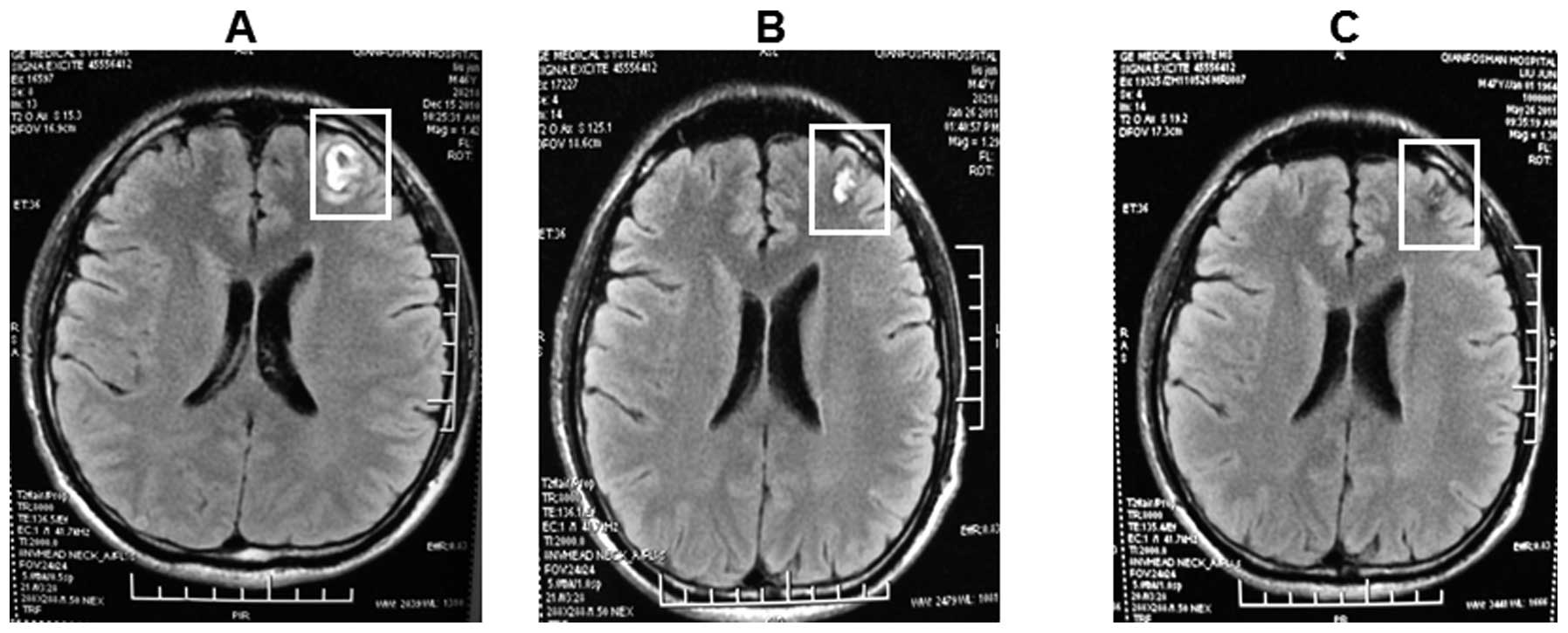Efficacy assessment of pemetrexed treatment of an NSCLC case with brain metastasis
- Authors:
- Published online on: August 30, 2012 https://doi.org/10.3892/ol.2012.888
- Pages: 1119-1121
Abstract
Introduction
Lung cancer, one of the most common malignancies, is a major cause of morbidity and mortality throughout the world. Approximately 80% of diagnosed lung cancers are non-small cell lung cancers (NSCLCs). In approximately 20–40% of NSCLC cases, metastasis to the brain occurs (1–3).
Pemetrexed, a multi-targeted antifolate drug, has been demonstrated in vitro to inhibit at least three different enzymes involved in the human folate pathway including thymidylate synthase (TS), dihydrofolate reductase (DHFR) and glycinamide ribonucleotide formyl transferase (4,5). These enzymes are involved in the synthesis of nucleotides, and ultimately pemetrexed is capable of interfering with RNA and DNA synthesis procedures (6). It was revealed that pemetrexed had a slightly higher brain penetration capability than methotrexate by the analysis of arterial blood and frontal cortex microdialysis samples obtained simultaneously (7,8). However, it remains unclear whether penetrexed is effective in NSCLC patients with progressive brain metastases. In the present study we report a successful case of pemetrexed treatment. Patient consent was obtained from the patient and the patient’s family.
Case report
A 46-year-old male patient presented with persistent pain in the left side of his neck, accompanied by low fever. An enlarged lymph node in the left side of the neck was subsequently discovered, which cervical magnetic resonance imaging (MRI) revealed to be a metastatic tumor. A mass (2.8x1.2 cm) was further visualized by chest computed tomography (CT), and was found to be localized in the posterior segment of the upper right lung. Multiple enlarged lymph nodes in the mediastinum were also detected. Multiple bone and brain metastases were detected by ECT and PET-CT, respectively. The primary lung cancer was diagnosed by histopathologic analysis, electronic bronchoscopy and lung biopsy which revealed a poorly differentiated adenocarcinoma. Although the patient had limited mobility in his neck, the rest of the examinations were normal. Potential mutations on the epithelial growth factor receptor (EGFR) and K-ras genes, obtained from the left cervical lymph node biopsy, were analyzed by DNA sequencing. It was revealed that exon 21 of the EGFR gene contained a heterozygous T to G mutation at nucleotide 2573. However, no mutations were found in the K-ras gene.
To treat the detected tumors, 900 mg of pemetrexed disodium (500 mg/m2; Eli Lilly, Indianapolis, IN, USA) was administered to the patient on day 1, and 40 mg of cisplatin (25 mg/m2; QILU Pharma., Jinan, China) was administered on days 1–3, with an interval of 3 weeks. Cervical radiotherapy (total dose, 4,200 cGy) was initiated simultaneously. Cetuximab (Merck, Whitehouse Station, NJ, USA) was injected during the second cycle of chemotherapy. Cetuximab (400 mg/m2) was administered on the first day, with weekly injections of 250 mg/m2 cetuximab thereafter. The treatment was terminated after 3 months.
After two cycles of chemotherapy, the brain metastases were reduced as revealed by brain MRI (Fig. 1). The lesion in the lung was reduced as determined by chest CT scans (Fig. 2). The systemic chemotherapy combined with the cetuximab injection was continued. After six cycles of treatment, a PET-CT scan was performed to examine the therapeutic efficacy. There was no abnormal FDG uptake in the brain or the lung. As a result, 900 mg of pemetrexed (500 mg/m2; Eli Lilly) was administered again every 3 weeks. Following the treatments described above, the tumor sizes were significantly decreased (Figs. 1 and 2).
Discussion
Lung cancer, one of the most common malignant tumors, is a major cause of morbidity and mortality. Approximately 80% of patients with lung cancers are diagnosed with non-small cell lung cancers (NSCLCs). Approximately 20–40% of NSCLC eventually metastasizes to the brain (1–3).
Pemetrexed, an antifolate drug, is known to inhibit at least three different proteins involved in the human folate pathway including thymidylate synthase (TS), dihydrofolate reductase (DHFR), and glycinamide ribonucleotide formyl transferase (4,5). These enzymes are involved in the synthesis of nucleotides, and ultimately pemetrexed is capable of interfering with RNA and DNA synthesis (6). Pemetrexed, in combination with cisplatin, has recently been used in the treatment of metastatic NSCLC patients (9–11). NSCLC patients with the exon 19 deletion have a distinctive pattern of brain metastases which usually present as multiple small metastases with low levels of brain edema (12,13). Certain studies have indicated that gefitinib and erlotinib penetrate into the central nervous system and elicit responses in NSCLC patients with brain metastases (13–15). It was revealed that pemetrexed had a slightly higher brain penetration capability compared to that of methotrexate, by the analysis of arterial blood and frontal cortex microdialysis samples obtained simultaneously (7,8). Bearz et al (16) investigated the therapeutic effect of pemetrexed on reducing brain metastases and revealed that PR (partial remission) was observed in 11 patients (28.2%) and SD (stable disease) was observed in 21 patients (53.8%). The total beneficiary rate was 82% (16). In our case, pemetrexed was proven to be effective even following the failure of radiotherapy. Our study suggests that pemetrexed is an effective therapy for patients with NSCLC (adenocarcinoma) and progressive brain metastases.











